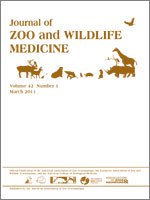Individual dietary preferences and difficulty with animal training create challenges and nutritional concerns when evaluating a captive sea otter (Enhydra lutris) diet. The importance of vitamin A within the body reflects the necessity that it be ingested in adequate amounts to ensure optimal health. To compare levels of serum vitamin A concentrations from captive sea otters on daily oral vitamin A supplementation, serum samples from eight adult sea otters from three institutions were evaluated for serum vitamin A concentrations. The eight animals were fed a total of four different diets and received oral supplementation via three different methods. Multiple diet items were analyzed for vitamin A content and were found to have low to nondetectable levels of vitamin A. Oral vitamin A supplementation, as a slurry with dietary items, was shown to be effective and a mean serum concentration of approximately 170 ± 51 µg/L was obtained for serum vitamin A concentrations in captive sea otters. Captive diets can be modified to increase vitamin A concentration and supplementation and, if accepted, can be used as a means to ensure adequate vitamin A intake.
How to translate text using browser tools
1 March 2011
Serum Vitamin A Concentrations in Captive Sea Otters (Enhydra lutris)
Alison L. Righton,
Judy A. St. Leger,
Todd Schmitt,
Michael J. Murray,
Lance Adams,
Andrea J. Fascetti
ACCESS THE FULL ARTICLE
Enhydra lutris
sea otter
serum concentration
supplementation
vitamin A





